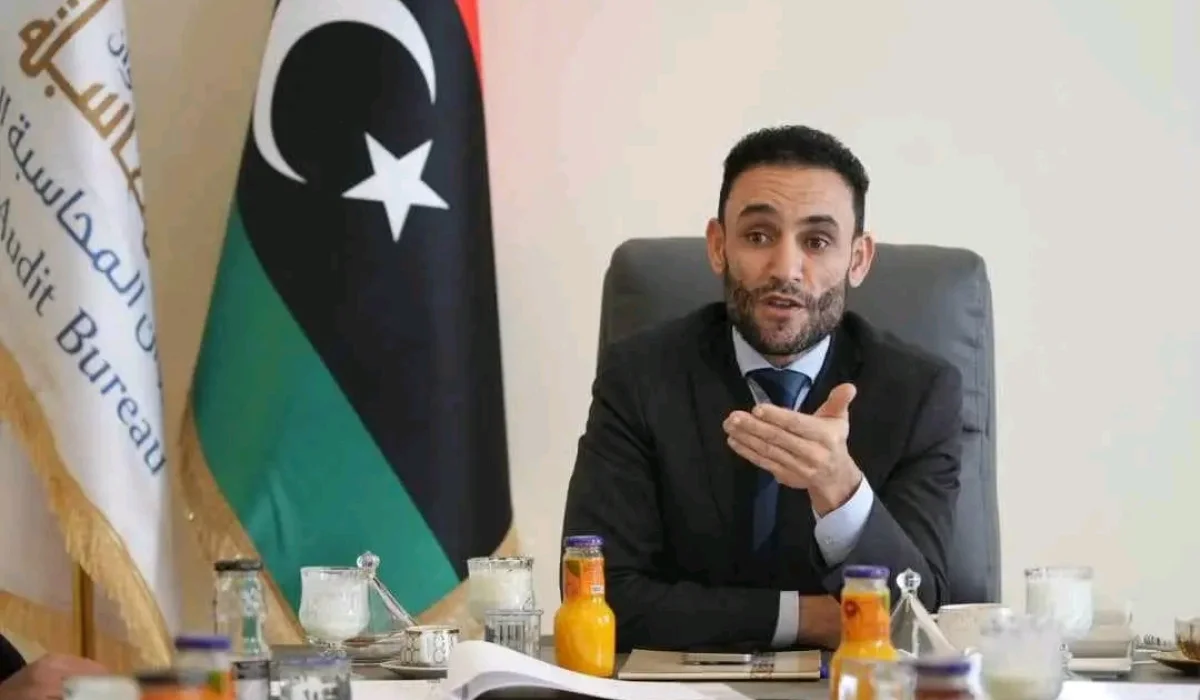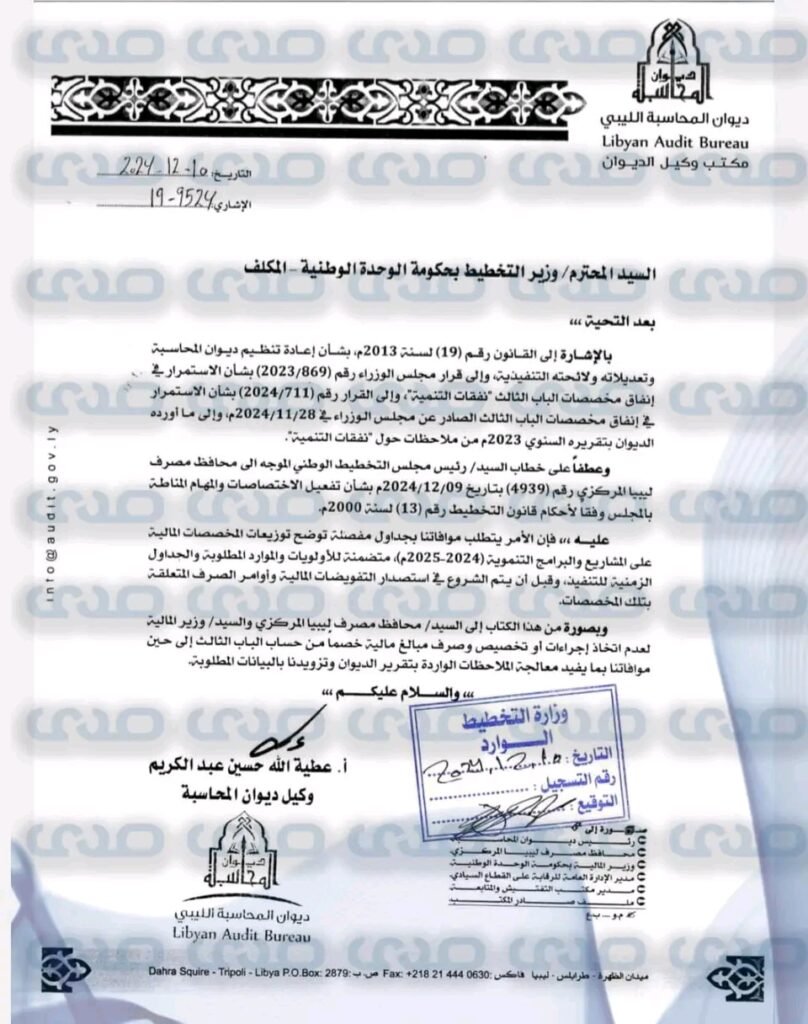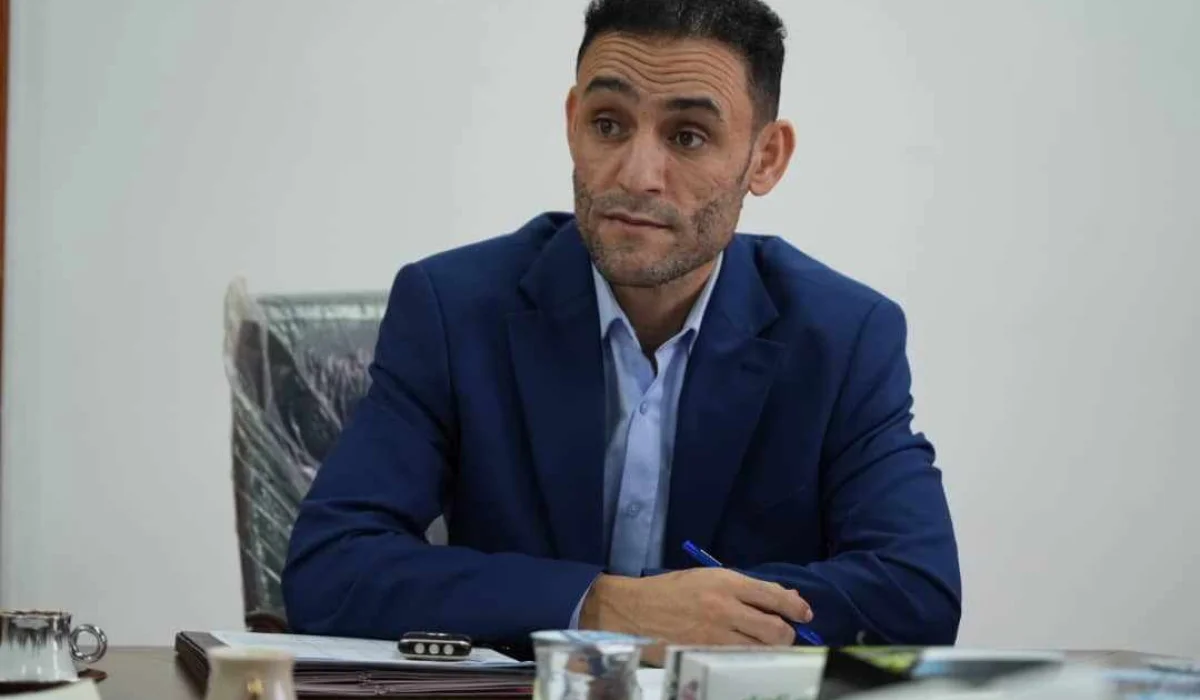The Sentry organization stated: On September 10, 2023, two dams near the city of Derna in eastern Libya collapsed due to a severe rainstorm, resulting in a flood that claimed the lives of at least 4,352 people and displaced approximately 45,000 others, while 8,000 individuals remain missing and are presumed dead. Since the disaster, journalists and NGOs have highlighted several factors contributing to this collapse, including suspected corruption that may have excessively weakened the dams.
In this report, The Sentry sheds light on these schemes and links them to the leadership of the Dbeibeh family in the organization responsible for developing administrative centers before 2011. It also illustrates how new risks associated with the Haftar family could lead to similar infrastructure failures in the future.
Among the factors contributing to the human and material losses in Derna was the poor condition of the dams. Between 2007 and 2010, the Libyan General Water Authority paid Arsel Construction Limited and other companies for rehabilitation works that were never carried out.
According to the organization, such negligence was part of a broader pattern of corruption that affected most non-oil-related construction and maintenance projects in Libya, especially in the years preceding the 2011 uprisings. Schemes like those involving the maintenance of Derna’s dams were largely executed through the “Administrative Centers Development and Management Authority,” a government entity then controlled by relatives of Abdulhamid Dbeibah, the current Prime Minister in Tripoli, western Libya.
Currently, after the disaster, reconstruction efforts are underway in Derna. In this context, the family of Field Marshal Khalifa Haftar, who governs eastern and southern Libya, has full control over new infrastructure contracts. Initial indicators suggest that the Haftar family may resort to corruption practices similar to those of the Dbeibeh family, potentially using foreign companies as a means to divert public funds.
Despite more than 15 years having passed, irregularities in the dealings between the Administrative Centers Development Authority and Arsel remain highly relevant to Libya today. They demonstrate how officials may have exploited existing companies to siphon off billions in public funds. This cross-border theft technique, or similar methods, may be employed in 2024, a time when large-scale infrastructure projects are being used by Libyan leaders to justify substantial public spending.
By exposing past fraud and scrutinizing current contracting practices, this report aims to contribute to preventing further corruption in Libya’s infrastructure sector, according to the organization.
Suspicious and Deliberate
In November 2007, the General Water Authority (GWA) awarded a $30 million contract to Arsel, a small Turkish company, for the maintenance of Derna’s dams—a decision heavily influenced by the Administrative Centers Development and Management Authority (ACDMA) and its leadership. In the years that followed, and until the 2011 uprisings, Arsel failed to perform any tangible work on Derna’s dams despite receiving regular payments from the Libyan state. This lack of performance can be traced to corruption practices involving ACDMA and its leadership, who benefited from the collusion of other parties involved in the project, including the GWA and Arsel management.
A thorough examination of the project’s negotiations, scope, payment records, and facilitation processes reveals a pattern of irregular behavior and clear signs of corruption. Such illegal practices and systemic failures not only contributed to the Derna disaster in 2023 but also mirrored similar issues that affected dozens of contracts in Libya before 2011, involving numerous foreign companies, many of them Turkish. The common denominator was the family controlling the ACDMA at the time—the Dbeibeh family.
Between 2007 and 2010, ACDMA awarded Arsel approximately 15 projects worth nearly $1 billion, significantly influencing the GWA’s decision to hire Arsel for the $30 million Derna dam maintenance project.
The Influence of the Administrative Centers Development Authority
The organization reported that Ali Dbeibah, a cousin of the current Prime Minister and head of the Administrative Centers Development Authority (ACDMA) from 1989 to 2011, exercised significant influence over the General Water Authority’s (GWA) decision in November 2007 to award a contract to Arsel for the maintenance of Derna’s dams. Between 2007 and 2010, ACDMA awarded Arsel a series of projects valued at nearly $1 billion, including parts of a university campus in Benghazi and housing units in Marj.
From selecting the Turkish company to managing its relationship with the Libyan state, Ali Dbeibeh controlled the discussions and negotiations with Arsel, heavily influencing the GWA’s decision to contract this company. Before ACDMA granted Arsel this billion-dollar package, the Ankara-based company was relatively unknown and lacked international experience, having previously handled only modest local projects averaging $20 million each. Nevertheless, the head of ACDMA favored Arsel over larger, more experienced Turkish companies, raising suspicions that Ali Dbeibeh may have had hidden motives behind this choice.
Illegal Practices, Not Mere Negligence
After the General Water Authority (GWA) signed the contract with Arsel in November 2007, the project faced unjustified delays lasting approximately 18 months. From April 2009, when the project finally began, until the outbreak of political unrest in February 2011, the Derna dams project was plagued by a series of administrative and operational irregularities, particularly in interactions between Libyan officials and Arsel.
Administrative Violations
The initial payments for the project bypassed standard procedures. Arsel received an upfront payment of about 25% of the total contract value, even though the usual practice at the time dictated a maximum advance of 15%, with at least a third of these payments held in escrow accounts. Additionally, Arsel failed to pay the mandatory 2% tax or the 0.5% contribution to the Social Security Fund. These exemptions suggest a deliberate effort by high-ranking Libyan officials to ensure Arsel had immediate access to funds, raising the likelihood of misappropriation or misuse.
The project scope also raises questions. In 2003, a Swiss consultancy assessed the situation in Derna and concluded that the two existing dams needed reinforcement, including the addition of hydraulic systems, and recommended building a third dam to ensure the safety of downstream residents. However, when Libya contracted Arsel in 2007, the project was limited to minimal structural reinforcements for the two existing dams, despite sufficient funds for more extensive work. More troublingly, after Arsel submitted its initial proposal for basic rehabilitation of the dams, Libyan officials insisted on an even more rudimentary version, suggesting a potential plan to reduce Arsel‘s expenses while allowing it to claim higher payments from the GWA.
Furthermore, despite the contract with Arsel not including the construction of a third dam—and no dam being built—the company falsely claimed on its website that its work in Derna between 2007 and 2012 involved “the construction of a third dam between them.” A lawyer representing the now-defunct Arsel declined to comment.
Project Management Failures
Beyond administrative violations, the Derna dams project was characterized by an unusual and seemingly corrupt arrangement of partners. In July 2009, the General Water Authority (GWA) contracted the Jordanian company Al Concord to participate in the Derna dam project. This task had been declared completed in July 2007 by Benaa wa Tasheed, a subsidiary of the Administrative Centers Development Authority (ACDA). Hiring another company for the same task two years later suggests that the Libyan entity had failed to complete the work and that Arsel could not fulfill its obligations. While Al Concord received its advance payment, it did not commence work, likely because Arsel had not completed its preceding stages, preventing Al Concord from starting its portion. In response to questions from The Sentry, a senior official from Benaa wa Tasheed declined to comment on the Derna dams but admitted the institution’s limited capacity.
For large-scale infrastructure projects, an initial consultant is typically hired to verify contractors’ progress throughout the project. However, in the case of the Derna dams, this critical step was delayed until 2010, when the GWA appointed the Italian consultant IRD. This delay indicates that Libyan decision-makers prioritized disbursing advance payments to Arsel before ensuring that all necessary components for actual implementation were in place—a behavior often associated with corruption.
Derna Dam Post-2011
Throughout the Derna dam project, GWA officials demonstrated a lack of oversight and considerable leniency toward Arsel’s non-performance. This behavior persisted even after 2011, increasing the likelihood that the initial appointment was tainted by corruption.
Following the fall of the Gaddafi regime, the new government in Tripoli adopted a policy encouraging foreign companies to resume pre-2011 projects. In response, Arsel employees returned to Al-Marj and Benghazi, likely motivated by the possibility of claiming half-payments for invoices issued and approved before the 2011 revolution. However, the Turkish company did not return to its sites in Derna.
Nevertheless, Arsel expressed dissatisfaction with not receiving payments due at the start of 2011 for its work in Derna, which was scheduled for completion in 2010. After years of bureaucratic correspondence, the GWA—now the Ministry of Water Resources—released the payments but did not request Arsel to return to Derna to complete the work. Nor did the authority attempt to recover its funds once it became clear that the work had not been executed.
During the same post-2011 period, the ACDA directly contracted another Turkish company, Karan Group, for excavation work as part of the Derna dams’ rehabilitation. As with Arsel, Karan Group did little to no work. This small Turkish company had direct ties to its predecessor; Karan Group’s leader, Sertac Karan, had held an executive position at Arsel before 2011, focusing on projects in the Greater Benghazi area. Post-2011, he worked with other Turkish companies in Libya, including his own. Karan Group participated in several ACDA-funded projects, including the Derna dam project from 2012 to 2016. A former Karan Group employee told The Sentry that Sertac Karan maintained relationships with the Dbeibeh family, even though they were no longer officially heading the ACDA.
In 2017, Arsel filed for bankruptcy due to financial difficulties, leaving creditors scrambling to recover any remaining assets. After the dams’ collapse in September 2023, reports emerged linking Arsel‘s failure to carry out maintenance work on the dams to the tragedy. In an attempt to shift the narrative, the Dbeibeh government helped propagate the idea that Arsel’s legitimate work in Derna was disrupted by the 2011 revolution. However, evidence suggests otherwise.
Administrative Centers Development Authority under Dbeibah’s Leadership
The suspicious behavior of “Arsel” in Derna was not an isolated case but rather reflected a broader issue characteristic of the General Projects Authority (Administrative Centers Development Authority) during the 1990s and early 2000s. Under Ali Dbeibah’s leadership from 1989 to 2011, the General Projects Authority employed dubious practices that hindered the completion of projects across Libya.
In 1998, Ali Dbeibeh implemented strategies to shield his organization from the substantial payment delays that plagued Gaddafi-era bureaucracy. By achieving greater financial independence from other state entities, the General Projects Authority ensured its ability to issue payments swiftly without interference from Gaddafi’s revolutionary committees or other bureaucratic controls. This autonomy made the Authority particularly attractive to foreign companies, especially those from Turkey. However, the Authority also became notorious for its lack of transparency.
Ali Dbeibah’s robust system was underpinned by strong family ties, with his relatives wielding significant influence across various sectors of Libya’s administrative apparatus—not just within the General Projects Authority. As head of the Authority, Ali was supported by his sons, Osama and Ibrahim, as well as his brother, Yousef. Ibrahim began to take on a prominent role starting in 2006. That same year, Ali’s cousin, Abdulhamid, became head of the Libyan Investment and Development Company (LIDCO), a real estate firm through which billions in public funds were funneled. LIDCO served three main state clients: the General Projects Authority, the Housing and Infrastructure Board, and the Civil Aviation Authority. Thus, in the regime’s final five years, the cousins operated in unison without oversight, leading to a dangerous overlap of interests.
Also in 2006, the General Projects Authority assumed control of “Benaa wa Tashyeed,” a state-owned construction company established during Gaddafi’s era. “Benaa wa Tashyeed” became an extension of the Dbeibeh family’s influence. In many of its projects, the General Projects Authority required foreign companies, including “Arsel,” to collaborate with “Benaa wa Tashyeed” in joint ventures for numerous projects unrelated to the Derna dam between 2007 and 2010. From a governance perspective, this arrangement posed a significant problem, as both the General Projects Authority and the Libyan company “Benaa wa Tashyeed” operated under the same family’s influence, creating a conflict of interest that undermined oversight and accountability. This jeopardized the integrity of the projects and weakened public interest.
Suspicions of misconduct were further fueled by the lack of evidence indicating that “Benaa wa Tashyeed” possessed the necessary capabilities to fulfill its prominent roles in these joint ventures. Responding to questions from The Sentry, a senior official at “Benaa wa Tashyeed” noted that, between 2006 and 2010, projects were awarded to the company centrally, based on favoritism rather than competence. The official added that this practice harmed project completion and pointed to the company’s poor financial health as a limiting factor in timely payments and its ability to attract qualified staff.
Under Ali Dbeibah’s leadership from 1989 to 2011, the General Projects Authority (Administrative Centers Development Authority) relied on questionable practices that undermined and delayed the completion of projects throughout Libya.
The period between 2005 and 2010, which saw these developments, was one of the most financially prosperous eras in Libya’s history. An agreement reached in December 2003 between the United States and Gaddafi’s regime lifted international sanctions, contributing to a national economic boom alongside high oil prices. As a result, hundreds of foreign companies flocked to Libya, and by the February 2011 uprising, Gaddafi’s regime was overseeing projects valued at over $70 billion, including more than $15 billion in contracts awarded to 200 Turkish companies operating in 100 different locations nationwide.
In eastern Libyan cities such as Tobruk, Benghazi, and Derna, 28 Turkish companies were engaged in projects valued at $3 billion. Despite these large figures, many projects failed to materialize as planned after contract signing.
As the number of projects increased, the pace of implementation for many Turkish construction projects in Libya slowed or halted entirely. This apparent slowdown coincided with the rise of corruption associated with the Dbeibeh family, which reached severe levels that hindered the execution of construction projects. According to testimonies from five former Libyan officials and a Turkish corruption expert, Ali Dbeibeh and his family members demanded commissions exceeding 15% during negotiations for infrastructure projects, particularly in the years leading up to the 2011 uprising.
The diversion of project funds into these bribes strained the budgets of foreign companies, shrinking their profit margins. This led to subpar execution and long delays, even though companies received their payments from the Libyan state on time.
From Qaddafi’s Tools to Uncontrolled Power Brokers
The Dbeibeh family was not merely a tool of Qaddafi and his sons, but rather became a center of discretionary power in pre-2011 Libya. Throughout the 1990s, the Administrative Centers Development Authority (ACDA), led by Ali Dbeibah, was exploited by the Qaddafi family as an instrument for illicitly diverting Libyan wealth, including circumventing international sanctions. However, by the mid-2000s, the Dbeibeh family had gained significant influence, enabling them to sometimes operate beyond the control of the regime.
In 2007, a corruption investigation led by a Libyan judge documented a series of high-profile corruption cases involving the ACDA and Ali Dbeibah. These included large-scale real estate frauds in Tripoli, such as unauthorized transfers of government offices and the provision of preferential housing to regime officials. The investigation revealed that the ACDA was paying inflated prices for properties, often unsuitable for their declared purpose, and the judge recommended criminal charges against Ali Dbeibeh and others.
Despite the comprehensive nature of the report, only limited action was taken, likely due to the involvement of key figures vital to the regime. However, the investigations clearly documented the growing independence and audacity of the ACDA under the Dbeibeh family, highlighting these trends since 2007.
In 2009, Saif al-Islam Qaddafi urged then Prime Minister al-Baghdadi al-Mahmoudi to encourage authorities to investigate Ali Dbeibah’s practices as head of the ACDA. In August 2010, most expenditures of the ACDA were frozen. A month later, under al-Mahmoudi’s direction, Ali Dbeibeh was replaced as head of the ACDA.
However, the legal issues surrounding Ali Dbeibeh and his dismissal were overshadowed by the civil unrest that began in early 2011. For foreign companies operating in Libya, the February 2011 uprising marked a major turning point, as tens of thousands of foreign workers, including employees of Arsel, were forced to leave the country.
With the regime change, some companies tried to capitalize on the opportunity to recover part of their operational losses, including those not related to the 2011 unrest, by blaming the events. However, these hopes largely went unfulfilled.
A Path Without Accountability
After Qaddafi, the Libyan judiciary was unable to scrutinize the Dbeibeh family’s record from the early 2000s, and the international response was insufficient, despite the severity of the allegations. This lack of accountability has contributed to the escalating corruption that is ravaging Libya today, with the tragedy of Derna being one of many consequences.
In February and March 2011, the United States and the United Nations imposed significant sanctions on Libyan economic institutions to curb the violent repression of popular uprisings. However, these sanctions did not target the ACDA or companies linked to the Dbeibeh family, such as LIDCO. While the European Union froze the assets of the ACDA in August 2011, it lifted these measures after a year and a half.
In 2014, Libyan prosecutors estimated that Ali Dbeibeh embezzled between $6 billion and $7 billion during his tenure as head of the ACDA from 1989 to 2011. The Libyan Attorney General’s office requested Scottish authorities to open an investigation and issued an Interpol Red Notice for him. However, after the retirement of Attorney General Abdelkader Ridwan, coinciding with the outbreak of a new civil war, the investigation stalled.
The ACDA continued to operate in Libya after 2011 under the leadership of Sherif Ibrahim Takita, a technocrat known for his loyalty to the Dbeibeh family. In 2016, a UN-backed government led by Fayez al-Sarraj took power, making Tripoli less hostile to those linked to the former regime.
The following year, Abdulhamid Dbeibah, who never relinquished his leadership of LIDCO, returned to the political scene. In October 2020, the United Nations Support Mission in Libya (UNSMIL) selected Ali Dbeibeh to be part of a 75-member committee of Libyan citizens tasked with preparing for elections. Ultimately, the committee selected Abdulhamid Dbeibah, Ali’s cousin, as the new prime minister amidst credible allegations of vote-buying.
The Return of Stalled Projects
A few months after taking office as Prime Minister in 2021, Abdul Hamid Dbeibeh announced his intention to revive “stalled projects in Libya” through the Administrative Centers Development Authority. While the authority’s activity has diminished compared to the period before 2011, it still holds some importance. The designs, plans, financial schedules, and administrative structures previously prepared by the authority provide a foundation for many companies hoping to reclaim their contracts.
This is especially true for Turkish companies that were active in Libya before 2011. Since then, the prices of many inputs have risen significantly, necessitating a review and amendment of the original contracts. However, Turkish companies that survived bankruptcy since 2011 have shown interest in reviving their old contracts with the authority, seeing their return to Libya as an opportunity to recover payments they believe they are owed.
From the Libyan side, however, there doesn’t seem to be much enthusiasm for meeting the demands of these companies.
The Grip of the Haftar Family on the Reconstruction of Derna
Although the Dbeibeh family retains power in the current Tripoli government, they have no influence over the ongoing reconstruction of Derna, which is tightly controlled by the family of Marshal Khalifa Haftar and his sons, especially Saddam, Bilqasim, and Khalid. Their approach to kleptocratic authoritarian rule, despite employing different tactics and drastically evolving Libya, poses risks similar to the harmful practices followed by the Dbeibeh family.
Don’t Ask, Don’t Tell, Don’t Know
A series of unilateral actions implemented after the Derna floods placed the Haftar family at the forefront of recovery and reconstruction efforts, granting them control over almost every aspect with minimal accountability. Their near-total control greatly increases the risk that a large portion of the public wealth allocated for reconstruction will be diverted for their benefit.
After the floods in 2023, Khalifa Haftar appointed his son Saddam to lead security after the disaster and oversee international rescue operations. As part of their attempt to deepen their dominance in eastern Libya, Haftar blocked Prime Minister Dbeibeh from visiting Derna, while the Haftar family instructed Prime Minister Osama Hamad, based in Benghazi, to stay away from any decisions related to reconstruction.
In a major move, the Speaker of the House of Representatives in February 2024 passed a law appointing Bilqasim Haftar, another son of Khalifa Haftar, as head of the Libyan Reconstruction Fund. This fund selects, negotiates, grants, finances, and manages many infrastructure projects in Haftar-controlled areas. The official legislation prohibits the Audit Bureau, the Administrative Control Authority, and other Libyan regulatory bodies from reviewing Bilqasim Haftar’s decisions or demanding transparency in his management of the reconstruction process. Other government bodies, such as the Ministry of Planning in Tripoli, are also excluded. Even the House of Representatives lacks oversight and knowledge of the details of most contracts signed by Haftar.
When it comes to Derna, the Reconstruction Fund under Bilqasim Haftar signs contracts through a unilateral, non-transparent process that avoids competitive bidding. Moreover, the total value of the contracts signed by Bilqasim Haftar for the reconstruction of Derna may amount to approximately 12 billion Libyan dinars (2.4 billion USD). In July 2024, the House of Representatives passed the Unified National Budget Law, which includes allocations for the reconstruction of Libya. Under this framework, the Libyan Central Bank is likely to review each project proposed by Bilqasim’s fund on a case-by-case basis to decide whether to issue the necessary letter of credit for each project. This leaves many gaps unaddressed, as the Central Bank of Libya is not tasked with being an enforcement or supervisory body responsible for ensuring the integrity of infrastructure contracts. When asked about how his fund finances its work, Bilqasim expressed confidence in the official Libyan budget law but remained vague on the details.
Bilqasim Haftar’s Reconstruction Fund is not the only body fully controlled by the Haftar family in the field of infrastructure. Even before the Derna floods, reconstruction was already a priority for the rulers of eastern Libya, which translated into the spread of committees and investment bodies. A key player in the reconstruction sector linked to Haftar is the National Development Authority, headed by Jibril Al-Badri, known for his close relations with Saddam Haftar.
All this means there is almost complete ambiguity under Haftar family rule: the Libyan people, Libyan regulatory bodies, and international entities have little, if any, access to a comprehensive reconstruction plan or details about the contracts, participating companies, alliance formations, financial allocations for each project, scope of work, or sources of funding.
Across Libya, illegal activities have increased, including in areas under Haftar’s control. In this kleptocratic boom, the opacity of the public-funded reconstruction process is particularly concerning, as the Haftar family and their affiliates may exploit this process for personal gain. Potential risks in infrastructure contracts include fraud in letters of credit and money laundering. If much of the construction work is handled through banks in eastern Libya, it will be easier for Haftar and his affiliates to carry out such schemes under the guise of legitimate work by private contractors.
What the Reconstruction of Benghazi Reveals About Derna
The ongoing reconstruction efforts in Benghazi, fully controlled by the Haftar family through the same institutional mechanisms as in Derna, provide valuable insights into how the Derna projects might unfold in the coming months. Benghazi, a city with a population of 800,000, endured more than three years of intense urban warfare between 2014 and 2017, with reconstruction efforts beginning only in 2022. Since then, the city has seen an increase in projects, and these construction initiatives have shaped Haftar’s approach to infrastructure. Similar methods, along with potential risks of abuse, are likely to be applied in Derna.
In Benghazi, Haftar’s infrastructure strategy often involves securing opaque deals with private companies, both foreign and Libyan, through a process that lacks public bidding. The process typically begins with an undisclosed amount of funding allocated for a prominent agreement with a foreign company that is selected and publicly announced. However, behind the scenes, the foreign company is often required to partner with a private Libyan company that has informal ties to Haftar or his allies. Allegedly, about half of the project’s nominal cost is paid to the Libyan company, which contributes little value, while the remaining half goes to the foreign company, which performs most of the work.
This practice raises concerns: officials representing the Libyan state should not secretly control the Libyan contractors they hire for construction projects. Such conflicts of interest increase the likelihood of financial irregularities and significantly raise the chance of diverting large portions of public wealth.
Regarding foreign partners, Haftar has favored Egyptian and Emirati construction companies so far. Among the Egyptian companies involved in the reconstruction of Benghazi are “Neom Real Estate Development,” owned by Ibrahim Al-Arjani, a friend of President Abdel Fattah El-Sisi; “Arab Contractors,” linked to the Egyptian Cabinet; and “Nile Valley Company,” known for its connections to Egypt’s General Intelligence Directorate. In August 2024, the National Development Authority, headed by Haftar’s son, Saddam Haftar, awarded the project for the “Greater Free Zone in Al-Merisa” to the UAE-based “Global Contracting.”
Turkish companies have also secured contracts in Benghazi, suggesting that they might achieve similar success in Derna.
Despite Ankara’s strong stance against Haftar during the 2019-2020 Tripoli war, Turkish diplomats, especially since 2022, have made significant efforts to warm up to Haftar and his family, aiming to help Turkish companies win economic opportunities in eastern Libya. Companies from China, France, South Korea, Canada, and other countries have also shown keen interest in contracts with Haftar’s family, although their political ties may be less robust than those of companies from Egypt, the UAE, and Turkey. Additionally, some Western companies are cautious about entering into direct contracts with the Belqasem Haftar Reconstruction Fund due to compliance concerns.
Among the most active Libyan private companies in construction projects in Benghazi are “Al-Rayan Holding” and “Imar Libya Holding,” both linked to Haftar’s son, Khaled, who serves as the Chief of Staff of Haftar’s security units based in the Qaryunis neighborhood of Benghazi. Furthermore, “Ibar Al-Alam,” which partnered with the UAE’s “Global Builders” in constructing the new Benghazi airport, is reportedly indirectly controlled by Belqasem Haftar. The spokesperson for Belqasem Haftar’s Reconstruction Fund in Libya did not respond to requests for comment. Neither did “Al-Rayan Holding,” “Imar Libya Holding,” or the spokesman for Haftar’s armed alliance respond to requests for comment.
Risks of Flawed Recovery
Interviews with Derna residents and eyewitnesses reveal that the ongoing recovery efforts in the disaster-stricken city appear more superficial than recommended by the World Bank. The Belkacem Haftar Reconstruction Fund has not sufficiently clarified its plan for restoring the city, but its actions suggest that speed and appearances may be prioritized over safety.
The World Bank’s “Rapid Damage and Needs Assessment” report, published after the 2023 floods, highlights the need to improve water, sanitation, and road infrastructure. It also emphasizes the necessity of rebuilding and upgrading electricity generators and water systems, with a focus on enhancing resilience against future extreme weather events. The report stresses the importance of building flood-resistant bridges and roads using durable materials and modern designs to adapt to climate change. For dams, the World Bank recommends comprehensive repairs.
Twelve months after what seems to be impressive work from the outside in Derna, there is little evidence that the authorities have committed to the World Bank’s recommendations. For instance, it remains unclear how the collapsed dams will be replaced, and there is no indication that new facilities will meet the recommended standards. Rumors suggest that the Libya Reconstruction Fund may invest in advanced repairs, including hydraulic systems, but there is widespread local skepticism. Some residents have expressed concerns about the companies that should take on the task, highlighting a problem of trust.
In the city itself, many Derna residents have welcomed the surface-level progress so far, such as renovated schools, new recreational facilities for children, and a new clinic. However, in-depth interviews with residents reveal that the recovery has been unbalanced. For example, the rehabilitation of Mazouaaj Darneis Club Street was comprehensive, including sewage, drinking water, and electricity. But efforts in other parts of Derna fail to address problems that have developed over decades in a city known for its lack of infrastructure. For instance, two Derna residents told “The Sentry” that despite the March 2024 announcement of the full renovation of a major street called Fanar Street, the actual work was superficial and limited to cleaning and repainting. A local source told “The Sentry” that the authorities only applied one layer of asphalt and expressed concerns that it would crack after a few years. One Derna resident, who lost two neighbors in September 2023, praised the repairs to some major streets by Belkacem Haftar but pointed out that other vital arteries severely damaged by the floods remained uninhabitable as of October 2024. Interviewees also expressed frustration with the state of alleyways and small side streets, many of which are still filled with debris. Others emphasized the ongoing lack of basic infrastructure, such as electricity and sewage systems, in large parts of Derna.
The way authorities have dealt with some Derna residents shows signs of politically motivated neglect. Dozens of families from the historic center, which was heavily impacted by the floods—an area that also bore the brunt of Haftar’s military campaign in 2018-2019—appear to have been marginalized in the post-flood rehabilitation process. While authorities are conducting widespread demolitions in preparation for rebuilding in those central neighborhoods, they offered to buy some of the residents’ homes at much lower prices than their market value. In 2023, Haftar’s family executed a more aggressive version of similar policies in central Benghazi, leading to the arbitrary and permanent displacement of many families. Haftar’s family may be implementing an approach aimed at forcibly dispersing some families from central Derna, with an unannounced goal of preventing political opposition from emerging there. Additionally, compensatory funds have not been distributed equitably, increasing the risks of injustice and bias.
Overall, the haste evident in Derna’s recovery today is typical of situations where political leaders are driven by incompatible incentives that negatively affect residents’ well-being. First, leaders seem to prefer enhancing their image through flashy announcements rather than committing to executing projects slowly and carefully. Second, these leaders may prioritize achieving immediate financial gains through upfront payments rather than allocating resources to implement high-quality projects. Such an approach contradicts the long-term success of recovery, as it leads to neglect of essential preparatory steps and the use of shortcuts that undermine the integrity of the final result.
No Room for Complacency
Between 2005 and 2010, Libya saw widespread corruption in infrastructure projects, with foreign companies used as channels to facilitate these violations. The lack of proper maintenance of Derna’s dams for many years prior to the September 2023 disaster is just one example of these practices. It is likely that a small group of senior Libyan officials stole billions of dollars without leaving a clear paper trail, leading to years of impunity and reinforcing the political ruling class’s control, not to mention the deterioration of national infrastructure.
These precedents of infrastructure-related violations from the mid-2000s require caution and vigilance regarding the ongoing reconstruction efforts in Libya. Although the circumstances differ, the current contracting protocols for reconstruction, including in Derna, should be subject to strict scrutiny, as patterns of concerning business practices may repeat. Many projects involve splitting contract funds between foreign companies and private Libyan entities with unofficial ties to Haftar’s family, opening the door to the potential diversion of funds. There is also a risk that some contracts involving Libyan companies may be used to facilitate fraudulent letters of credit, including for money laundering purposes. Such potential use and contribution to the manipulation of Libya’s public wealth threatens the efficiency, sustainability, and viability of all newly announced infrastructure projects by Haftar’s family. Therefore, transparency is crucial for these publicly funded contracts, especially given Haftar’s secretive and opaque approach.
As for the Dbeibeh family, which currently governs in Tripoli, its members must also be held accountable for their suspected illegal practices since the mid-2000s. Moreover, the Dbeibeh government—since 2021—bears at least some, if not much, responsibility for the Derna disaster. The Dbeibeh Prime Minister’s offices did not respond to a request for comment.
The ongoing deterioration in the management of Libya’s economy calls for a reassessment, both internationally and locally, of pressure mechanisms and accountability. If systemic gaps remain unaddressed, increasing corruption in Libya will continue to accelerate, with potential consequences that may include a return to economic upheaval or armed conflict.
Recommendations
United States and Allied Countries:
- Combatting Corruption: Increase pressure on ruling families and their business partners to reduce corruption in Libya. Despite regional allies like Turkey, Egypt, and the UAE tolerating Libyan corruption, the focus should be on curbing this issue.
- Reconstruction of Derna: Engage with the Libyan Central Bank’s leadership to ensure transparency in reconstruction contracts, especially those linked to Haftar. Avoid allowing non-transparent credit letters for these projects and encourage more transparency in spending.
- Audit Support: Strengthen support for the Audit Bureau to investigate past and current corruption, particularly in infrastructure projects. USAID should increase collaboration with the bureau, including funding international audit firms, and ensure the Bureau can work without threats.
- Accountability in National Budget: Improve transparency in development spending, particularly in sectors beyond Derna. The Ministry of Planning and the Central Bank should release detailed project reports and progress updates.
- Linking Transparency to Sanctions: Connect calls for transparency from Libyan leaders with targeted sanctions against their closest partners involved in illegal activities. This is crucial, as reconstruction relies mostly on Libyan resources, with limited foreign donations.
- Support Civil Organizations: Back trustworthy civil organizations that mobilize Derna’s diaspora to contribute skills and efforts to rebuild the city. These initiatives aim to foster greater transparency and solidarity.
- Investigate Fraud: Revive investigations into fraud, especially regarding the Derna dams scandal and the Administrative Centers Development Authority, which involves the Dbeibeh family.
UN Security Council:
- Maintain Sanctions: Continue sanctions on Libyan Investment Authority assets until they comply with sovereign wealth fund principles and provide comprehensive accounts. The Security Council should remain firm, even if Libyan officials cite Derna recovery as justification for asset freeze exceptions.
International Banks:
- Increase Vigilance: International financial institutions should be cautious of the risk that Haftar’s camp may use reconstruction projects to launder illicit funds. They must scrutinize all reconstruction-related transactions and enforce anti-money laundering measures.
Libyan Ministries and Public Institutions:
- Digitize Company Registries: Make private company records public to expose illegal companies tied to government officials, preventing misappropriation of public funds.
- National Infrastructure Maintenance Taskforce: Establish a national task force to assess and monitor the country’s infrastructure, ensuring adequate maintenance across Libya, especially after recent disasters. The team should include existing bodies such as the National Planning Council and Ministry of Planning, and address the increased vulnerability of Libya to climate change impacts.



















